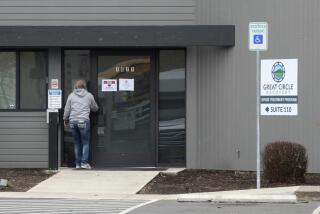Wagons Rumble Again on Historic Oregon Trail : Pioneers: Re-enacting the 2,000-mile great migration after 150 years, a wagon train heads West with a ‘pickled’ body.
- Share via
ODELL, Neb. — Willie Keil’s pickled body was strange cargo, even on the Oregon Trail in 1855, where unusual sights were commonplace.
Willie was 19 that spring in Bethel, Mo., and excitedly looked forward to joining his family on the great migration that opened the West and changed the course of American history.
When Willie took sick with cholera and died, his father, William Keil, a self-proclaimed physician and preacher, kept his promise to take his eldest son to the Oregon Territories. He packed Willie’s body in a zinc-lined coffin filled with alcohol, loaded it on a wagon and set out with the rest of the family.
The sorrowful journey is being re-enacted in 1993, part of a 20th-Century wagon train that is following the historic 2,000-mile trail from Independence, Mo., to Oregon City, Ore. This year marks the 150th anniversary of the trail’s opening in 1843.
Willie’s family settled in what became the town of Aurora, Ore., a few miles south of Oregon City on the Willamette River. “Now we, the present residents of Aurora, are symbolically bringing Willie home,” said Earl Leggett, driver of the two-mule team that carries a tin coffin holding a mannequin representing Willie.
Leggett and nearly 30 other people have been on the trail more than a month, and expect to be on it until October.
The Keils were among the nearly half a million Americans who, inspired by the doctrine of Manifest Destiny, walked or rode across the prairie and over the Rocky Mountains in the 1840s, ‘50s and ‘60s, seeking new lives in the promised land of the Pacific.
In commemoration of the sesquicentennial of the hazardous, often heartbreaking trek, thousands of Americans are taking part in observances this summer.
Many of the festivities are planned by towns and cities in the six states through which the Oregon Trail passed: Missouri, Kansas, Nebraska, Wyoming, Idaho and Oregon.
The Aurora-bound wagon joined five Conestoga wagons that left Independence on May 2, a century and a half to the day after about 1,200 emigrants set out with the first big wagon train.
The 1843 train touched off an unprecedented exodus. Rarely in history have so many people traveled so far over such a vast wilderness.
By 1840, the young nation’s receding frontier had come to an abrupt halt at Independence. Beyond lay the Great American Desert, the Rocky Mountains and the Pacific Ocean.
In 1804-06, Meriwether Lewis and William Clark had explored westward to the Pacific, but the spacious territory between Independence and the ocean remained largely a mystery.
In 1812-13, trappers who followed Lewis and Clark up the Missouri River and into the Rockies found a better way into the Rockies after their encounters with hostile Blackfeet Indians.
Their alternate route was South Pass, a broad, saddle-like break at the end of the Wind River Range in what is today Wyoming. The route became the Oregon Trail, the wagon ramp through the Rockies.
During the 1840s, the main trail branched off in several places. One branch, the Mormon Trail, would take thousands of Mormons southward into Utah. Another would carry thousands of gold-seekers to California.
This year’s expedition should roll into Oregon City early in October, said wagon master Morris Carter, an outfitter and hunting guide from Mills, Wyo., whose great-great-grandfather came up the trail in 1846.
Along the way, the organizers expect to have as many as 30 or 40 wagons at various times, traveling various distances. Accompanying the wagons are contingents of horseback riders.
Participants are urged to wear period costumes. Whenever possible, they follow wagon ruts, still etched on the grassy plains in many places. Sometimes they must take to nearby roads. At night they usually sleep in tents.
“Several of the communities we’ve gone through have opened up their high school gyms so we can shower and have a dry place to sleep,” Carter said. “For the first three weeks of the trip, we experienced rain nearly every day, probably just like the early pioneers did. I can’t tell you how good a hot shower feels after slogging through the mud all day.”
The pioneers of 150 years ago never even imagined a hot shower. Much of their journey was sheer misery. Contrary to legend, few of them were killed by Indians, but thousands, like Willie Keil, fell to cholera and other diseases.
Willie, even though he never saw the trail, is well-remembered by the citizens of Aurora, population 614. Their re-enactment was two years in the making.
“The community worked together and paid $4,500 for the pair of mules--Sue and Annie--and $1,800 for the harness,” Leggett said, “and the wagon is on loan from the museum in Aurora.”
When the wagon finally rolls into town, the coffin, which is draped with the flag of Aurora, will be buried in a dignified ceremony. Inside will be a time capsule, to be opened in 100 years.
More to Read
Sign up for Essential California
The most important California stories and recommendations in your inbox every morning.
You may occasionally receive promotional content from the Los Angeles Times.













